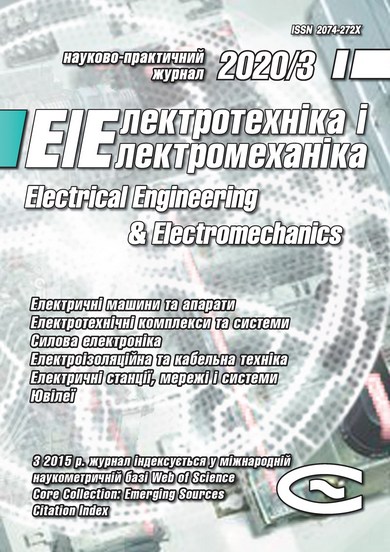INVESTIGATIONS OF THE DYNAMICS OF A BISTABLE ELECTROMAGNET WITH IMPROVED CHARACTERISTICS FOR MEDIUM VOLTAGE VACUUM CIRCUIT BREAKERS
DOI:
https://doi.org/10.20998/2074-272X.2020.3.01Keywords:
bistable electromagnet, actuator, vacuum circuit breaker, multiphysics modelAbstract
Introduction. Currently, for switching medium voltage circuits, vacuum circuit breakers are widely used, which have good arcing properties and high breaking capacity. One of the problems of creating the drive mechanism of such apparatus is the need to ensure the absence of contact welding when a through current of a short circuit of a given duration flows through them, which is achieved due to a certain amount of contact pressure. One of the problems arising in the design of circuit breakers is the need to fix the mechanism with a mechanical lock, which should hold the mechanism securely. This leads to significant specific mechanical loads, which in turn reduces the reliability of the circuit breaker. One way to solve these problems is to create a drive based on monostable or bistable electromagnetic actuators with highly coercive permanent magnets, which provide reliable fixation of the position of the contacts. Purpose. Investigation of the improved design of a bistable electromagnetic actuator based on permanent magnets of a medium voltage vacuum circuit breaker. Methods. Theoretical and experimental research and comparative analysis of existing and developed electromagnetic actuators. Conclusions. A new design of an electromagnetic bistable actuator with reduced overall dimensions is developed and tested. The electromechanical characteristics of the actuator correspond to the technical specifications, which is confirmed by both theoretical and experimental studies. The proposed actuator can be used as a drive mechanism for medium voltage vacuum circuit breakers.References
Klymenko B.V. Elektrychni aparaty. Zahalnyi kurs [Electric apparatus. The general course]. Kharkiv, Tochka Publ., 2013. 400 p. (Ukr).
VM1-T. Vacuum circuit-breaker. Available at: https://library.e.abb.com/public/e9408d38c8324932ac60aa9e935e481a/MA_VM1-T(EN)-_1VCD601412%20-%20BA%20543-02.pdf (accessed 06 April 2019).
Klymenko B.V., Bugaychuk V.М., Grechko A.М. A pre-production model of two-position electromagnetic drive for an average-voltage vacuum switch. Electrical engineering & electromechanics, 2005, no. 2, pp. 23-27. (Rus).
Baida E.I. Fuzzy dynamic response of a bistable electromagnetic actuator based on high-coercitivity permanent magnets. Electrical engineering & electromechanics, 2012, no. 5, pp. 18-20. (Rus).
Ro J.-S., Hong S.-K., Jung H.-K. Characteristic analysis and design of a novel permanent magnetic actuator for a vacuum circuit breaker. IET Electric Power Applications, 2013, vol. 7, no. 2, pp. 87-96. doi: 10.1049/iet-epa.2012.0176.
Bayda Ye.I., Vyrovets S.V. Characteristic of monostable actuator starting. Naukovyi Visnyk Natsionalnoho Hirnychoho Universytetu, 2013, issue 6, pp. 72-77. (Rus).
Klymenko B.V., Vyrovets S.V., Forkun Ya.B. Elektromagnitnyj pryvid [Electromagnetic actuator]. Patent UA, no. 15210, 2006. (Ukr).
Bugaychuk V.M., Klymenko B.V., Varshamova I.S., Grechko O.M. Elektromagnitnyj pryvid [Electromagnetic actuator]. Patent UA, no. 130401, 2018. (Ukr).
Baida E.I. A mathematical model for calculating the dynamics of on-off electromagnetic actuators of medium voltage vacuum circuit breakers. Journal of scientific publications of graduate students and doctoral students, 2013, no. 1, pp. 136-141. (Rus).
Grechko A.M. Experimental research of eddy currents in the magnetic core on dynamic characteristics of the electromagnetic actuator, Bulletin of NTU «KhPI». Series: Problems of Electrical Machines and Apparatus Perfection. The Theory and Practice, 2012, no. 49 (955), pp. 9-17. (Rus).
Downloads
Published
How to Cite
Issue
Section
License
Copyright (c) 2020 E. I. Baida, B. V. Klymenko, S. V. Vyrovets, Michael G. Pantelyat, M. Clemens

This work is licensed under a Creative Commons Attribution-NonCommercial 4.0 International License.
Authors who publish with this journal agree to the following terms:
1. Authors retain copyright and grant the journal right of first publication with the work simultaneously licensed under a Creative Commons Attribution License that allows others to share the work with an acknowledgement of the work's authorship and initial publication in this journal.
2. Authors are able to enter into separate, additional contractual arrangements for the non-exclusive distribution of the journal's published version of the work (e.g., post it to an institutional repository or publish it in a book), with an acknowledgement of its initial publication in this journal.
3. Authors are permitted and encouraged to post their work online (e.g., in institutional repositories or on their website) prior to and during the submission process, as it can lead to productive exchanges, as well as earlier and greater citation of published work.





